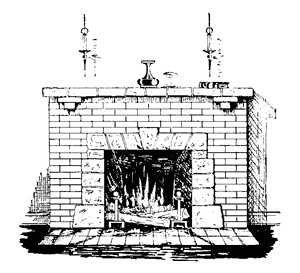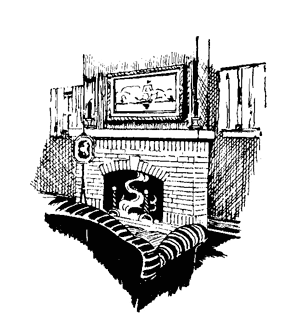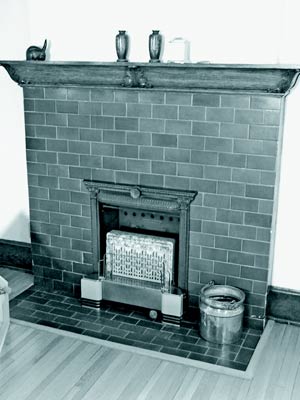Small Home Gazette, Winter 2008
Answers to Your Toughest Bungalow Questions: fireplaces
A: A glowing log in the fireplace is a classic emblem of the bungalow—the family gathered ‘round the hearth, warm and cozy in their very own “artistic” home. Few experiences can match a wood fire for evoking a sense of nostalgic comfort.
And let’s face it—a fire is fun. It snaps, crackles and pops; its warmth is delicious; and as an adult you’re allowed to play with it—rearranging it with a poker and adding logs are part of the timeless fireplace ritual. It’s a truly interactive experience.
These days, however, such an experience is difficult to enjoy without a few unpleasant facts creeping into one’s thoughts. The biggest spoiler: An open fire sucks the heat right out of your home. Fire needs oxygen for combustion, and the handiest oxygen is in your home’s interior. So while the flames create warmth for those sitting next to them, they’re drawing the air in your rooms—air you’ve paid dearly to heat with your furnace—right up and out the chimney. It’s enough to send shivers up the spine.
 And as you’ve learned, wood fires are messy. You must buy and store firewood, haul it into the house (possibly along with bugs), and later shovel the ashes out of the firebox and dispose of them. Smoke may sometimes belch into your living room, and there’s always the chance a log may roll out of the firebox or embers land on your rugs or floor.
And as you’ve learned, wood fires are messy. You must buy and store firewood, haul it into the house (possibly along with bugs), and later shovel the ashes out of the firebox and dispose of them. Smoke may sometimes belch into your living room, and there’s always the chance a log may roll out of the firebox or embers land on your rugs or floor.
There’s even more bad news: Wood fires pollute. Burning wood releases particulates and gasses into the air (and into your home), contributing to poor air quality, which is especially problematic in urban areas where multiple pollutants combine to affect everyone’s health, but especially those with respiratory illnesses.
What’s a bungalow dweller to do? Many simply choose to use their wood-burning fireplace on occasion anyway, as one of life’s little guilty pleasures. Perhaps the authentic experience of a once-in-a-while wood fire is worth the drawbacks.

If you’re not willing to do that, the most common solution is to install a sealed gas fireplace insert. Inserts are available to fit any size firebox and come complete with ceramic embers and stacked “logs.”
Gas inserts solve most of the negatives of a wood fire. A gas fire is instantaneous, burning bright with the flip of a switch. There’s no wood to buy, store, carry or clean up after. And though the flames are real, they won’t consume volumes of your home’s heated air because they’re virtually sealed off from the room. What’s not to like?
Well, several things, actually. Despite advances in gas inserts’ ability to mimic a wood fire, it’s still fairly easy to spot an imitation. A sure giveaway is the ceramic logs—because they aren’t consumed, they don’t pulse in shades of red, yellow and orange like real logs do. There’s no snap, crackle and pop, and a fire that’s just been switched on looks identical to one that’s been burning for an hour. Kinda boring. And then there’s the wall of glass that separates you from the flames. Though it radiates heat, it’s still a barrier. No poking or stirring allowed.
To many people, watching a gas fire is only marginally better than watching a fireplace on television. How long will it be before you just don’t bother to turn it on?
Though an open wood fire and a sealed gas insert are your primary choices, variations of both are available.
Freestanding wood burning stoves are one option. These units, some of which are quite compact, sit in front of your fireplace on a pad; the flue runs out the back and up the chimney. They will give you the look and feel of a real wood fire, albeit one behind glass. And as airflow is closely controlled, they consume much less of your home’s interior air when compared to the gaping hole of a fireplace opening. Some are designed to burn wood pellets or other fuel instead of logs, which are purportedly more efficient and less polluting. But they intrude into the room and rupture the aesthetics of the fireplace.
If you lean toward the tidiness of a gas flame, there are also options.
First, if you’re willing to stretch the definition of a fire to include a bed of coals in a basket, gas versions are more convincing than units with fake logs. The ceramic “coal” chunks have an undulating glow that mimics real embers.
In many cities (Minneapolis, for example), gas fireplaces don’t have to be sealed—in other words, no glass barrier. The downside is that the damper (the mechanical metal flap that blocks the chimney) must be permanently locked open. This means your home’s heated air will flow up the chimney at all times, not just when the fire is burning.
Luckily, there’s a solution. A Minneapolis business, Woodland Stoves and Fireplaces (www.woodlandstoves.com), carries a product called Flue Sentinel. This system includes an electronically controlled damper mechanism that mounts on the top of the chimney. When you turn on your gas fire, a signal is sent up to the damper, which opens before allowing the fire below to ignite. Pretty nifty.

This original fireplace, located in a Minneapolis Foursquare home, has no flue or chimney. It was built with an outlet for an electric heater in the back of the firebox.
Finally, it may be comforting to know that not all original bungalow dwellers were wood-burning purists. We’ve seen a number of early-20th century Twin Cities homes with masonry fireplaces that were never meant to hold a fire—they were built with no chimney or flue, just a shallow firebox and an outlet for an electric heater.
How’s that for authenticity?











